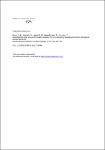Investigation of a New Electrostatic Sampler for Concentrating Biological and Non-Biological Aerosol Particles
Roux, Jean-Maxime
Kaspari, Oliver
Heinrich, Renate
Hanschmann, Nicole
Grunow, Roland
The detection of airborne pathogens is becoming a subject of great concern in modern day society. Recent studies have shown that electrostatic samplers are suitable for collecting microorganisms as well as preserving their viability. In most of these studies, flow rates were lower than 12.5 L/min or required a concentration stage to increase the flow rate to 100 L/min. In the present study, a single stage electrostatic sampler was developed for an efficient collection of microorganisms at 100 L/min. The design is based on the positive DC corona between coaxial cylinders to continuously create charged particles as they pass through the sampler. The physical collection efficiency of the device was investigated by sampling the ambient air particles. The efficiency in collecting live biological samples was determined by sampling live bacterial spores with the collector situated inside an aerosol chamber. It is shown that particles of 0.3–0.35 μm are captured with an efficiency of about 86%, whereas cultivable spores of Bacillus thuringiensis are collected with an efficiency of about 94%. Results are compared with an analytical predictive model. The experimental results are similar to the efficiencies previously reported in the literature; however, the current sampler design features a higher flow rate which enables the device to be used as an alarm trigger in a shorter period of time.
No license information

